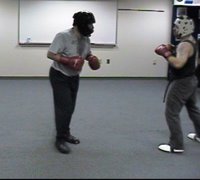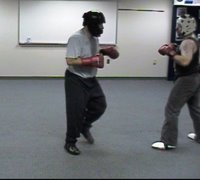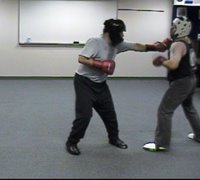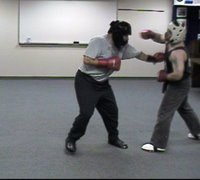[Click photos to enlarge]
 1. The lead-off fighter (on your left) begins to lead.
1. The lead-off fighter (on your left) begins to lead. 2. Notice the foot moves before the hand, allowing the counter-fighter to anticipate the attack-you can see his lead foot come forward a little, allowing him to put his weight into the counter.
2. Notice the foot moves before the hand, allowing the counter-fighter to anticipate the attack-you can see his lead foot come forward a little, allowing him to put his weight into the counter. 3. The lead. Notice it's low, and the lead-off fighter's weight hasn't shifted. This indicates the lead is tentative and uncommitted. It doesn't warrant a good defense because it (a) won't penetrate, and (b) won't do much damage. It doens't demand respect.
3. The lead. Notice it's low, and the lead-off fighter's weight hasn't shifted. This indicates the lead is tentative and uncommitted. It doesn't warrant a good defense because it (a) won't penetrate, and (b) won't do much damage. It doens't demand respect. 4. The lead is low, leaving a nice opening over top of it. The counter fighter has done a snap-back (see rear foot), by stepping back slightly, while keeping his weight forward. He begins to fire even as the jab is still out.
4. The lead is low, leaving a nice opening over top of it. The counter fighter has done a snap-back (see rear foot), by stepping back slightly, while keeping his weight forward. He begins to fire even as the jab is still out. 5. Where is the rear guard? There is a clear path for the counter right. This is where keeping the elbow up and the punch high provide the cover we mentioned above.
5. Where is the rear guard? There is a clear path for the counter right. This is where keeping the elbow up and the punch high provide the cover we mentioned above. 6. Completion of the counter. Notice the lead-off jab was withdrawn low, which contributed to the opening for the counter-right.
6. Completion of the counter. Notice the lead-off jab was withdrawn low, which contributed to the opening for the counter-right.

No comments:
Post a Comment